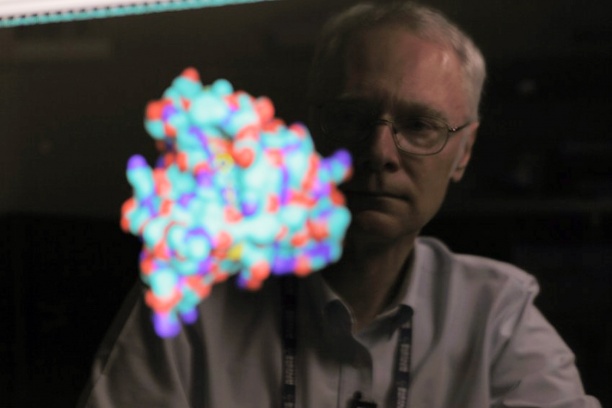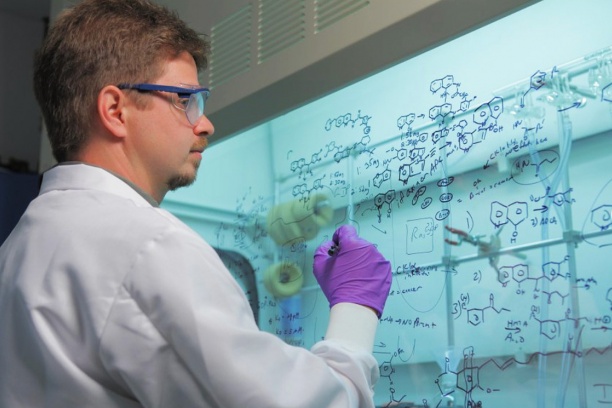Laboratory Overview
The Fesik laboratory comprises three large lab spaces with equipment, benches, and seating capacity for up to 45 researchers. The lab contains all the necessary resources and equipment to perform activities critical to early-stage drug discovery, including NMR-based screening, biochemical assays, protein expression and purification, molecular and cell biology experiments,and the design, synthesis, and purification of new compounds. The space contains fourteenchemical fume hoods, a shared cell culture room with four biohoods, a fermentor room, and a shared cold room. Computational resources to meet both routine needs and more intensive in silico studies are also available to lab members. The lab’s resources are supplemented by access to a significant amount of state-of-the-art shared equipment, including NMR spectrometers, X-ray diffractometer, crystallization and imaging robots in the structural biology core facility, electron microscopes in the Cryo–Electron Microscopy Center, instrumentation in the High Throughput Screening Core and Mass Spectrometry Core, and additional equipment for compound synthesis and purification in the Vanderbilt Institute of Chemical Biology’s Molecular Design and Synthesis Center. In addition, the lab has regular access to the synchrotron X-ray source at the APS in Chicago and rapid access at the ALS in Berkeley, California
Shared Facilities
The Fesik Lab has access to the services and expertise available in the many Core facilities that Vanderbilt maintains to supplement the available capabilities of the Fesik Lab and otherresearchers. Among these are the Mass Spectrometry Core, the High-Throughput Screening Core, and the Molecular Design and Synthesis Center.
The High-Throughput Screening facility is designed to support industrial-scale laboratory automation and is fully equipped with state-of-the–art readers, liquid handling, laboratory automation, and laboratory information management systems (LIMS) needed to perform complex cell-based and cell-free assays to support Vanderbilt investigators in basic and translational research. The HTS Core also maintains the Vanderbilt screening collection, which currently numbers more than 160,000 discreet compounds and the Fesik Fragment Library of over 15,000 compounds.
The Molecular Design and Synthesis Center, directed by Dr. Gary Sulikowski and staffed with full-time synthetic and medicinal chemists, supports the Vanderbilt community in all aspects of medicinal chemistry and organic synthesis. This fee-for-service core can accomplish the synthesis of quantities of known or unknown compounds with an emphasis on parallel synthesis of small libraries for hit/lead follow-up, HPLC purification of mixtures, and scale-up of compounds to up to 100 g scale.
Computer
The Fesik lab has access to the necessary computational resources to meet both routine needs and more intensive in silico studies. To process and analyze structural data we have three Dell T3500, 8 processor Xeon 3.2 GHZ linux workstations equipped with 16 GB of memory andNividia graphics boards. Each scientist has an Mac or PC personal computer on his or her desktops. Software is maintained and updated through membership in the Structural Biology Grid at Harvard Medical School (SBGrid) which is a computing collaboration of more than 120 X-ray crystallography, NMR, and electron microscopy laboratories. This software includes major NMR packages (e.g. NMRPipe, Xplornih) and X–ray packages (e.g. CCP4, HKL-2000, Phaser, Buster TNT). Modeling software such as Dock (UC San Francisco), Sybyl (Tripos), InsightII(Accelrys), MOE (Chemical Computing Group), Maestro (Schrodinger) and open source tools like Autodoc and Pymol are accessed through site licenses of the Vanderbilt Structural Biology Computing group. Pipeline Pilot is obtained through a shared license with the Vanderbilt Institute of Chemical Biology (VICB) HTS group.
EQUIPMENT
Protein Preparation
 The lab contains all the necessary equipment to clone, express, and purify proteins such as an Bio-Rad T100 Thermal Cycler for running PCR and two E-Gel iBase and E-Gel Safe Imager systems for DNA agarose gel electrophoresis and collection.
The lab contains all the necessary equipment to clone, express, and purify proteins such as an Bio-Rad T100 Thermal Cycler for running PCR and two E-Gel iBase and E-Gel Safe Imager systems for DNA agarose gel electrophoresis and collection.
Other related equipment includes: a -80 °C freezer to store competent cells and proteins; a -20 °C freezer to store enzymes, plasmids and reagents; a bench-top and floor model refrigerated shaker/incubator; a BioFlo 415 fermentor for cell culture growth; bench-top and floor model centrifuges for cell harvesting; and a APV 2000 cell homogenizer for lysing cells.
Large scale protein purifications are carried out using three AKTA Pure units set up in chromatography refrigerators along with a collection of high volume columns including Ni-NTA, Glutathione Sepharose, SP Sepharose, Heparin Sepharose, Q Sepharose, Sephacryl S100 and S200, Superdex 75, Jupiter C4, G25 desalting and HIC.
Protein quantization is carried out with the NanoDrop 2000c using A208, Pierce BCA and Pierce 660. Proteins are concentrated using Amicon cells ranging from 4 mL to 380 mL in capacity.
X-ray Crystallography
Crystallization screens are designed and prepared using the TTP Labtech Dragonfly and protein crystallization drops are set up with the nano-dispensing Mosquito robot. The crystallization plates are stored in three vibration-free crystallization incubators capable of temperature programming, and crystals are observed using the Formulatrix RockImager or an Olympus SXZ16 stereomicroscope equipped with a 5MP digital camera. Additionally, cryogenic tools, dewars, and a dry shipper from VWR are used for cryo-crystallography and synchrotron data collection.
 X-ray crystallographic experiments will be performed using the Bruker D8 Venture MetalJet high brilliance generator equipped with a CCD detector, or a synchrotron source. Vanderbilt owns a 1/2 share of the Life Sciences Collaborative Access Team (LS-CAT) beamline which provides over 40 days of synchrotron experiments per year
X-ray crystallographic experiments will be performed using the Bruker D8 Venture MetalJet high brilliance generator equipped with a CCD detector, or a synchrotron source. Vanderbilt owns a 1/2 share of the Life Sciences Collaborative Access Team (LS-CAT) beamline which provides over 40 days of synchrotron experiments per year
NMR Spectroscopy
NMR experiments are conducted in the Biomolecular NMR facility in the Center for Structural Biology, which houses one 500, two 600s, one 800, and one 900 MHz Bruker NMR spectrometers, most with a cryoprobe, as a shared resource.

For NMR-based screening, the 900 MHz and 600 MHz NMR spectrometers are equipped with a Sample Jet sample changer capable of handling batches of up to 480 samples.
Cell Biology
All the equipment necessary to carry out the cell biology experiments is available in our lab or is available for use in the Molecular Biology Core, Cell Biology Core, High Throughput Screening Core, and the Flow Cytometry Shared Resource Core which occupy lab space immediately adjacent to or in close proximity to our group. This equipment includes 4 laminar floor cell culture hoods, 8 temperature–controlled incubators (including CO2 regulated incubators and a refrigerated incubator), centrifuges, and a wide selection of instrumentation, including: 2 LiCorOdyssey imaging systems, multiple Real-Time PCR Detection Systems, an FLA7000IP Typhoon Storage Phosphorimager, two Panoptic kinetic imagers, two ImageXpress XL microsope imager(one confocal), a Seahorse xF Pro extracellular flux analyzer, several multimode microplate readers, a Digital ChemiDoc MP Imaging System, multiple flow cytometers and cell sorters, two Echo 555 acoustic liquid handlers, Bravo and VPrep automatic pipette-based liquid handlers, 2Dewars for cryopreservation, a coulter counter, a bioreactor, an electroporator, and light microscopes.
Chemistry
The chemistry portion of the lab consists of 14 fume hoods furnished with the requisite stir plates, manifolds, and glassware to each support a functioning chemist and the equipment necessary to synthesize and purify compounds.
This equipment includes: an Agilent analytical LC/ MS system equipped with an additional Varian 380 ELSD detector, three

Gilson preparative HPLC systems, 6 ISCO combiflash purification systems, a Biotage Initiator-60 microwave synthesizer, ventilated chemical storage, and sufficient vacuum pumps, rotary evaporators, balances, refrigerators, freezers, and other associated equipment to support a fully functioning medicinal chemistry laboratory.
We maintain a wide selection of polymer supported or resin-bound reagents and scavengers (e.g. PS-Trisamine, MP-carbonate, PS-DCC, etc) to enable parallel chemistry, faster reaction workups and purifications. In addition, through the Vanderbilt Institute of Chemical Biology’s Molecular Design and Synthesis Center, the chemistry team has access to additional specialized equipment, including a Varian Polaris 211 analytical HPLC system with PDA and autosampler dedicated to chiral analyses, a Varian Prepstar SD1 preparative scale HPLC dedicated to chiral purifications, three large capacity chiral preparatory columns, a Parr hydrogenator, an H-Cube hydrogenator,high pressure hydrogenation apparatus, an ozonizer, and an Autopol III automatic polarimeter.Within the Mass Spectrometry Core facility, 41 mass spectrometers, including MALDI and TOF instruments, are available for non-routine experiments.
Computing
Each member of the Fesik lab has a personal computer and access to a number of standard computing programs. In addition, three linux work stations are available in the lab for molecular modeling and docking experiments. The lab members have access via subscription to a number of shared software packages, including the Molecular Operating Environment (MOE),Schrodinger’s Maestro package, the ChemCart database containing the Vanderbilt compound collection, and Pipeline Pilot, via the HTS Core and/or the Center for Structural Biology. High performance and throughput computing are handled by three primary systems. The Advanced Computing Center for Research and Education (ACCRE) maintains a 1200-processor compute cluster with 1.5GB of RAM per processor. The CSB faculty typically access ~15% of ACCRE. The facility is operated by ACCRE staff, who are supported through user fees.
The Center for Structural Biology (CSB), of which Dr. Fesik is a member, maintains additional high performance computing resources: an SGI Altix system with 32 Intel Itanium2 CPUs and 64GB of RAM, and a 25-node cluster with 624GB of RAM and 200 Intel Nehalem processor cores interconnected with a 40 Gbit Infiniband fabric. These systems are all interconnected to a 20TB high performance gigabit Ethernet network-attached storage system which facilitates data sharing between all the above computing resources and local workstations. These CSB facilities are operated by the CSB Computing Core, which is responsible for supporting all local computing resources. This group keeps the central computers and network updated, trouble-shoots, coordinates for outside repair and service contracts, does regular data backups and maintains shared software and databases, remote access into the network, color and black-and-white laser printers, and a data management system for short-term and archival file storage. The CSB Computing Core is supported through a system of user fees. Access to a comprehensive suite of continually updated and optimized structural biology software packages is provided through the SBGrid consortium, which charges an annual fee for this service.